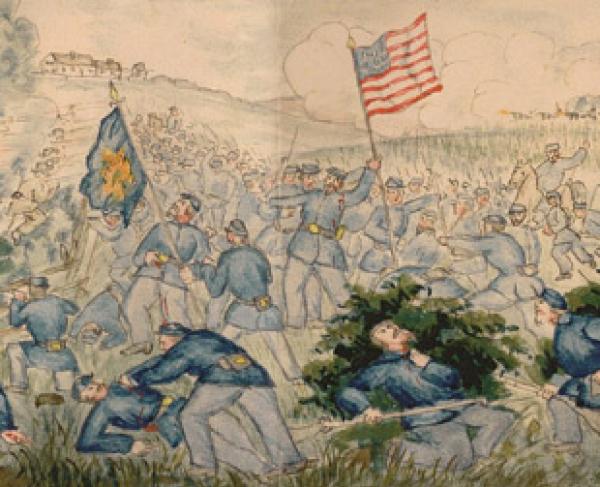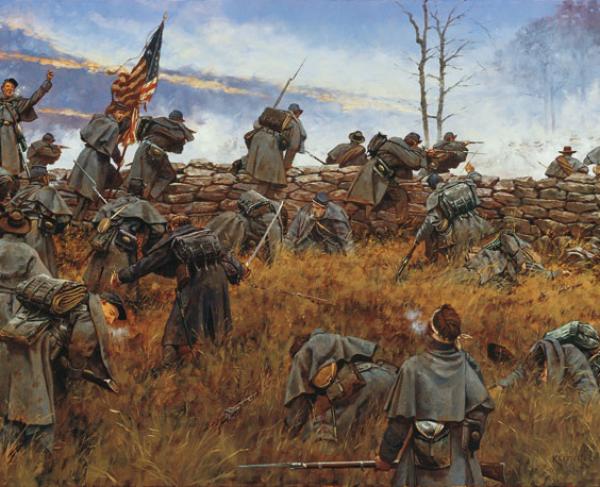Stonewall Marches Through the Shenandoah
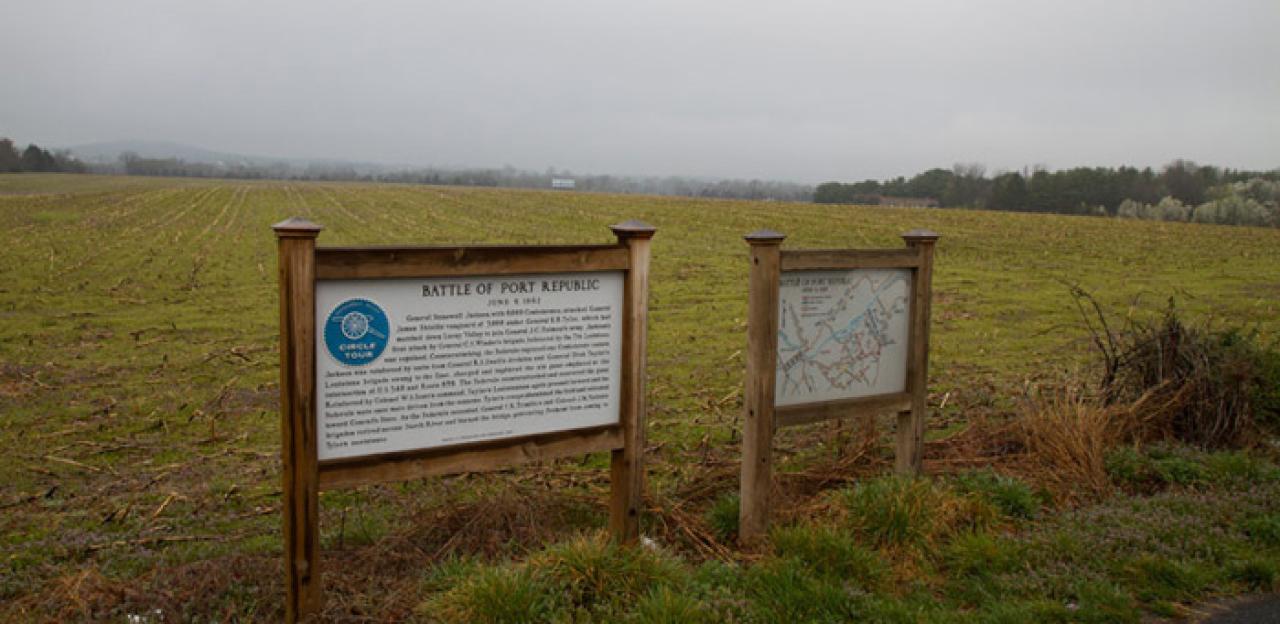
Don Pfanz, for Hallowed Ground
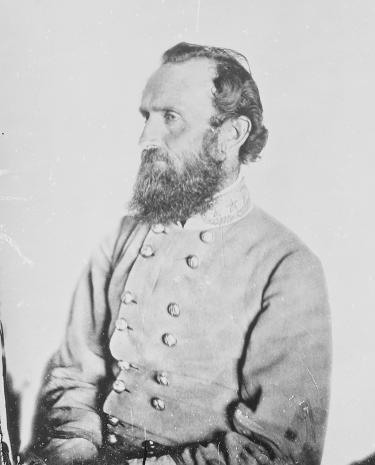
In May 1862, a pall hung over the Confederacy. Across the nation, Northern armies were on the march, driving Confederate forces from Kentucky, Tennessee and Missouri. In the East, Union forces seized important footholds along the Atlantic seaboard, and in the South, Union gunboats blasted their way into New Orleans. The young Southern nation stood on the brink of collapse.
In Virginia, matters looked equally grim. The Union had gained control over the western part of the state, established troops in the lower Shenandoah Valley and Fredericksburg, and was inexorably making its way toward Richmond by way of the Peninsula. Outnumbered Southern troops braced for the inevitable, and seemingly irresistible, onslaught.
Onto this desperate stage burst Gen. Thomas J. "Stonewall" Jackson. The 38-year-old Jackson commanded Confederate forces in the lower Shenandoah Valley. Jackson's objective was to defend the Valley while at the same time preventing Union troops there from being sent to either Fredericksburg or Richmond. It was a daunting task. As the spring campaign opened, Jackson had just 4,600 men at Winchester. Opposing him was a force of approximately 30,000 Union troops led by Maj. Gen. Nathaniel P. Banks. When Banks advanced on Winchester in March 1862, Jackson had no choice but to give ground.
The odds against Jackson fell dramatically in following weeks as Banks detached large portions of his army to reinforce Federal forces east of the Blue Ridge Mountains. Seeing his chance, Jackson rushed north and struck Banks' depleted army at Kernstown. Jackson suffered a tactical defeat, but his fierce attack impelled Banks to recall one division to the Valley and prompted Union authorities to undertake an offensive there.
Banks' army, now numbering 19,000 men, began its advance up the Valley on April 17. Again, Jackson had no choice but to fall back. He led his small force toward Conrad's Store (modern Elkton) at the southern end of the Massanutten, where he would be in position to block Banks' progress. From there he would also be able to support Brig. Gen. Edward "Allegheny" Johnson, who with 3,000 men was disputing the advance of Maj. Gen. John C. Fremont. Fremont had 20,000 Union troops scattered throughout the Allegheny Mountains, which bordered the Shenandoah Valley to the west.
At Conrad's Store, Jackson received substantial reinforcements in the form of Maj. Gen. Richard S. Ewell's division, numbering 8,000 men. Leaving Ewell at Conrad's Store to watch Banks, Jackson led his own division east across the Blue Ridge to Mechum's River Station. There, his troops boarded waiting cars of the Virginia Central Railroad and doubled back over the mountains, uniting with Johnson's force near Staunton. Together Jackson and Johnson overpowered the vanguard of Fremont's army near the village of McDowell and pursued it more than 30 miles up the South Branch Valley to Franklin.
Having driven Fremont's forces away from Staunton, Jackson rejoined Ewell in the Shenandoah Valley. Their forces together numbered 17,000 men. Jackson's target was Banks, whose once-formidable army had dwindled to just 8,000 men. Banks had fallen back down the valley and was busily fortifying Strasburg. Rather than attack the Union defenses head on, Jackson crossed the Massanutten at New Market Gap and advanced up the Page Valley toward Front Royal. One thousand Union soldiers garrisoned the town. Jackson fell like an avalanche upon the unsuspecting Federals and took 800 prisoners.

The capture of Front Royal threatened Banks' line of communication, and he evacuated the town and fled north to Winchester. Jackson followed in hot pursuit. On May 24, he sliced into the rear of the Union column at Middletown and pursued the main body north to Winchester.
Banks made a stand on the hills south of town and awaited the attack Jackson willingly obliged. While Ewell engaged the Federals' attention on the Front Royal Road, Jackson launched his main assault along the Valley Turnpike. Brig. Gen. Richard Taylor's Louisiana Brigade turned Banks' right flank and sent the Union army reeling in defeat through Winchester.
Vigorous pursuit might have spelled disaster for Banks' troops, but the Confederates were not up to the challenge. Jackson's cavalry was badly managed that day, and his foot-sore infantry was too worn down by weeks of campaigning to keep pace with their better rested counterparts in the Union army. Banks' army reached Williamsport on the Potomac River in safety, covering 35 miles in a single day.
Jackson headed in a different direction. After resting his troops near Winchester, he slowly advanced toward Harpers Ferry. His goal was to threaten the Potomac line, thereby relieving the pressure on Richmond. Little did he know that he had already accomplished that goal. No sooner had word of his May 23 attack on Front Royal reached Washington than Union authorities ordered reinforcements to the Valley in an effort to crush Jackson once and for all.
Maj. Gen. Irvin McDowell led two divisions west from Fredericksburg to Front Royal, intent on cutting off Jackson's retreat east of the Massanutten. At the same time, Fremont headed east toward Strasburg with 15,000 troops in an effort to block Jackson's retreat up the Shenandoah Valley. With McDowell and Fremont at his rear and Banks in front, Jackson would be surrounded by no less than 50,000 troops.
He eluded the trap by the narrowest of margins. On June 1, after two days of forced marches, Jackson slipped between Fremont and McDowell at Strasburg. Rather than uniting forces, Fremont and McDowell pursued Jackson by different routes. While Fremont followed the Confederates directly down the Shenandoah Valley, McDowell's leading division, commanded by Brig. Gen. James Shields, moved by a parallel route up the Page Valley, east of the Massanutten. That was a critical mistake. By dividing their forces, Fremont and McDowell put themselves in a position to be defeated in detail.
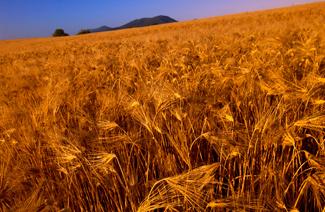
Jackson grasped this and set a course for Port Republic. Here the North and South rivers join to become the South Fork of the Shenandoah. By controlling the North River bridge at Port Republic, Jackson could strike at either Shields or Fremont. If he got into trouble, he could destroy the bridge — effectively placing the swollen river between him and at least one of his two foes.
Jackson's march to Port Republic was fraught with difficulty. Spring rains had saturated the countryside, and when the Confederates left the macadamized turnpike at Harrisonburg and turned east onto the unpaved Port Republic Road, their wagons were mired in mud. Fremont's cavalry, led by Brig. Gen. George D. Bayard, bore down on the struggling Confederate column. Just outside Harrisonburg, Jackson's cavalry chief, Col. Turner Ashby, ambushed the Federal horsemen, taking some 60 prisoners, including the British adventurer Sir Percy Wyndham.
The loss of Wyndham prompted the aggressive Bayard to push forward additional troops, including a battalion of Pennsylvania riflemen known as the Bucktails. Ashby determined to punish the upstart Federals. "They have had their way long enough," he remarked to a fellow officer. "I am tired [of] being crowded and will make them stop it after today." Ashby posted a section of artillery in the road as bait, then led a brigade of infantry through the woods to the right in an effort to take the Federals in flank as they tried to capture the guns.
But it was Ashby rather than the Federals who got the surprise. As the Confederates made their way through the woods, they encountered the Bucktails posted behind a fence at the edge of the timber. Ashby charged with his leading regiment and was shot through the heart. His troops fell back, but Confederate reinforcements under Ewell took the Bucktails in flank and drove them from the wall with slaughter. The Federals did not press Jackson's column any more that day.
Jackson now found himself confronted by Federal forces on both sides of the South Fork: Shields to the east and Fremont to the west. Jackson divided his command, taking his own division to Port Republic and leaving Ewell at Cross Keys, four miles back, to check Fremont.
Fremont struck first. On June 8, he encountered Ewell's division at Cross Keys and deployed for battle. He directed his primary thrust at the Confederate right, which he mistakenly determined to be Ewell's "strategic flank." While his artillery engaged the Confederates in a furious bombardment, Fremont sent forward five regiments under Brig. Gen. Julius Stahel to find Ewell's flank. Instead, Stahel collided with Brig. Gen. Isaac R. Trimble's brigade. The feisty 60- year-old Marylander had his 1,500 men lie prone behind a fence at the edge of a clover field, half a mile in advance of the main Confederate line. As Stahel's leading regiment crossed the field, Trimble's men let loose a point-blank volley that, in their commander's estimation, "dropp[ed] the deluded victims of Northern fanaticism and misrule by scores." Stahel's leading regiment, the 8th New York, lost about 200 men. The survivors of the deadly volley quickly disappeared into the woods whence they came. When they did not reappear, Trimble counterattacked and nearly captured a Union battery.
Union troops on Fremont's left and center were just coming to grips with the Confederates when news of Stahel's repulse reached Union headquarters. Fremont immediately called off his attacks in those quarters and ordered his troops back to Keezletown Road. As evening came on, Ewell threw the wings of his division forward but wisely refrained from renewing the battle.
Jackson meanwhile had his hands full at Port Republic. Early in the day, as the Battle of Cross Keys was just beginning, Union horsemen dashed into Port Republic without warning. Jackson had his headquarters in the town and narrowly escaped capture. Mounting quickly, he galloped across the North River bridge amid a hail of gunfire and joined his troops on the crest beyond. Corralling the nearest regiment, he ordered it to retake the town. The Confederates did so, driving the Federal horsemen back across the South River.
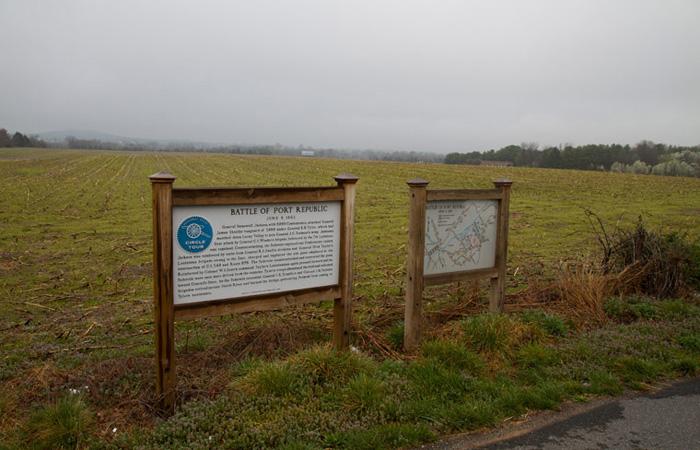
The horsemen heralded the approach of Shields's column. Later that day, two brigades of Union infantry appeared down river from Port Republic near Samuel H. Lewis's house, "Lewiston." Brig. Gen. Erastus B. Tyler commanded the force. Tyler deployed his troops in a sunken lane that stretched across the fields between Lewiston and the South Fork. Directly above Lewiston, perched on a spur of the Blue Ridge, stood "the Coaling," a place where the Lewis family produced charcoal for its blacksmith shop. Tyler posted six cannon there capable of sweeping the plain across which the Confederates would have to advance in order to attack the Union line.
Jackson was undeterred by the natural strength of Tyler's position. On June 9, he ordered Brig. Gen. Charles S. Winder across the South Fork with the Stonewall Brigade to attack Tyler's line. As Winder's men approached the lane, Federal gunners at the Coaling stopped them in their tracks. Jackson ordered up artillery in an effort to silence the Union battery but his gunners had no success. Infantry would have to do the job.
The previous night; Jackson had ordered Ewell to bring his division to Port Republic, leaving behind a rear guard to hold Frêmont's force in check. As Ewell's forces poured across the South River, Jackson seized the first brigade — Taylor's Louisianans — and sent them through the woods to flank the troublesome Union cannon. Taylor's men seized the Coaling just as Winder's men were giving way below, and they turned the captured guns on the heretofore victorious Federals. At the same time, Confederate reinforcements jogging up from Port Republic surged forward, routing the Federals and driving them from the field.
The Confederate victory at Port Republic marked the end of Jackson's 1862 Valley Campaign. Although casualties were modest compared to those of later campaigns, the Valley Campaign's strategic consequences were immense. By the bold use of his small force, Jackson diverted Union troops and resources away from Richmond, saving that city from almost certain capture and the nation it represented from almost certain ruin. Just as important, Jackson's victories gave the Southern people hope and breathed new life into the struggling Confederacy.
Strategically the 1862 Valley Campaign ranks as one of the great masterpieces in military history. Yet its battlefields remain largely unprotected. The battle sites at Front Royal and Winchester have virtually disappeared under development, Kernstown and Harrisonburg battlefields seem likely to share that fate. There is some good news, however. Small portions of the McDowell, Cross Keys and Port Republic battlefields are owned by the APCWS, and most of the land outside APCWS control retains its natural appearance. But that may not last. The commercial and residential growth that has obliterated battle sites in the lower Valley is slowly creeping south. Battlefields that have remained virtually unchanged for 136 years may in the next few years be the targets of unprecedented development. These historic sites need to be purchased — and quickly — if they are ultimately to survive.
PORT REPUBLIC: CLOSE OF A CONFEDERATE VICTORY
Nearly nine acres on the hill known as the "'The Coaling" during the Civil War were donated to the Civil War Trust in December 1989 by the Lee-Jackson Foundation. In 1995 the Civil War Trust began working with the 42nd Virginia, a Confederate reenactment group, to provide access and interpretation of the site. The project was completed in June 1996. The property was the key to the Union position and the site of the most intense action during the battle. Most of the site is now in thick woods, but a good view of the battlefield can be seen from the interpretive trail, particularly when the leaves are off the trees.
The Civil War Trust owns nine acres of "The Coaling." The modern house at the top of the hill is privately owned. "The Coaling" was operated by the Lewis family, whose home "Lewiston" stood close to the base of the hill on the site now occupied by a large white house.
The village of Port Republic still retains its Civil War appearance. Several houses date back to the war, including the George Kemper House, where Jackson had his headquarters, and another Kemper house where Turner Ashby's corpse was brought following his death on June 7 at the Battle of Harrisonburg. Also visible is the bridge used, by the Confederate army to cross the North River on the morning of June 9. Jackson burned the bridge later in the day to prevent Fremont's army from crossing the swollen river. Today only the abutments survive.
Parking is provided in the lot of the Grace Episcopal Church, by, the United Daughters of the Confederacy marker. Be sensitive to services and events being held at the church. Use caution in crossing the road (Route 708) to reach the interpretive trail. At the Civil War Trust sign, take a brochure, then enjoy the walk up the interpretive trail.
The rest of the battlefield can be seen from the public roads that bound the area of combat. Please remember that these areas are in private hands and are not accessible without that owner's permission. For further information on the Civil War history of the area, you can visit the Harrisonburg-Rockingham Historical Society in Harrisonburg, or write the Society of Port Republic Preservationists at P.O. Box 82, Port Republic, VA 24471.
From Harrisonburg, take Port Republic Road, (Rte. 659), through Port Republic to Rte. 340. Turn left and drive about 1 1/2 miles to route 708. Look for brown directional marker which reads: "Port Republic Battlefield Marker." Turn right on 708. Park at the marker in front of the Episcopal Church. Alternate approaches; From Elkton Lake take Rte. 340 south, and from Waynesboro take 340 north.
FOLLOW JACKSON'S TREK AT MCDOWELL
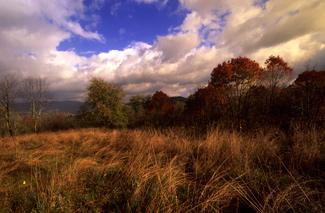
The Civil War Trust purchased 126.5 acres of the McDowell battlefield in 1990, and secured easements on nine more acres. The property consists of the top of Sitlington Hill, where the Confederate battle lines were located and the heaviest fighting occurred. The easement provides access along the ascent route used by Southern troops. The land is heavily wooded with some open fields. The purchase price was $64,000.
Located in Highland County, Va., this battlefield is situated in the Allegheny Mountains of the Appalachian Range. The terrain is extremely rugged, characterized by steep, rocky ridges. The Civil War Trust property covers the top of Sitlington Hill, which is part of Bull. Pasture Mountain. The hilltop has a commanding and spectacular view over the town of McDowell just to the west.
Some of the acreage is old pasture, while hardwood and hemlock cover the rest. The terrain has remained much as it was in 1862. The old Staunton-Parkersburg Turnpike (Rte. 250) borders the property, and an additional 100 acres of the battlefield is preserved by the Lee-Jackson Foundation.
The battlefield is well preserved, but difficult to access. The property can be seen from public roads, but to walk the battlefield requires a hike. This area is rugged, and even the easiest trails can be steep. Future plans call for a pull-off, trail, and wayside exhibits, but at this time all trails are unimproved, so sturdy shoes and appropriate preparations should be made for hiking. Relic hunting and off-road vehicles are prohibited. Special use of the land may be allowed, but prior written permission must be obtained from the Civil War Trust.
From Interstate 81, exit at Staunton, Va., take Route 250 West. This essentially follows the Staunton-Parkersburg Turnpike. Follow 250 for about 30 miles. Once across the crest of Bull Pasture Mountain you will approach McDowell. On the left you will see a highway marker noting Sitlington Hill. Shortly afterwards there is a parking area on the right. Park here.
Across the road is a monument erected by the United Daughters of the Confederacy. This is the northwest corner of our property. The fenceline behind the monument forms the western boundary up to the top of Sitlington. There are two ways to get up the hill. You may enter our property in the field just to the left of the UDC marker and work your way uphill as best you can. This will be strenuous, and covers about a half mile. There is a TV antenna wire running to the top of the hill which can be used for reference. Your goal is the field at the top of the hill where the antenna is located. This was the location of the 12th Georgia.
A better option is to walk back east on 250 about one-quarter mile. Walk on the left and use caution as there is very little shoulder. On the other side of 250 you will see a metal gate and a meadow beyond the gate. Carefully cross the road, open the gate and continue up Sitlington Hill using that trail. This is the trail APCWS will eventually use as its interpretive trail. Be sure to ask ahead for our McDowell Site Bulletin.
Stonewall Brigade (1st)
All hail to the heroes whose
valour daring
Have driven the ruthless
invaders away
Who won us the blessed
relief we are sharing
Who purchased the peace
we are tasting today
There is grief in our hearts,-
There are tears on our faces
The dearest have fallen - the
noble the brave
And we sigh as we think of
the desolate places
Where these we have cherished
lie dead in their graves.Chorus:
But gallant defenders;
we crown you with song
We twine you the wreath
that to victors belong
We shout o'er you
"le triumphe" with glee
Our Valley, our beautiful
Valley is free.
They fought not for glory.
They strive not for honor
Virginia their darling lay
bleeding and torn
The clutch of a Tyrannus
hand was upon her
And how dare the insult be
brooked or be borne
Nay rather come death and
they faint not nor faulter
Tho many a chivalrous
bosom has bled
And poured a libation on
liberty's altar
As pure and as holy as ever
was shed.
"Stonewall Brigade" Song
Courtesy of VMI Archives. William W. Bentley letter. Manuscript 4117, 1862, June 13
Related Battles
684
288
590
718
256
498
1,002
816
